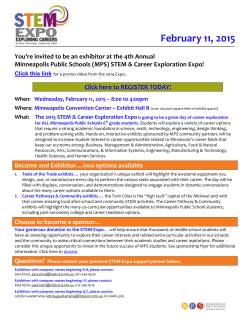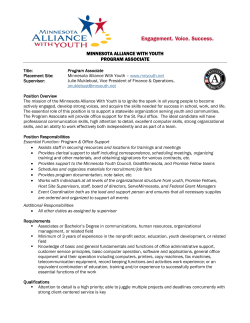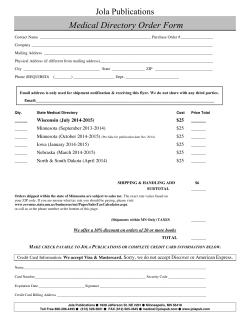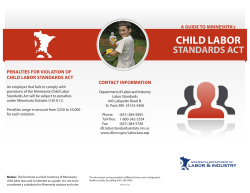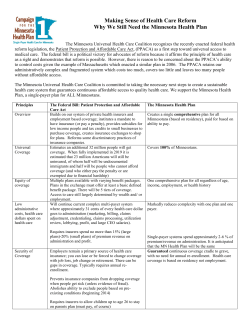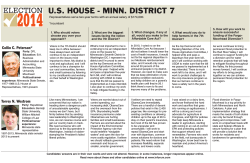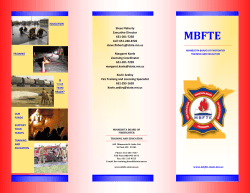
2014 SciTechsperience Internship Program Report
Minnesota High Tech Association SciTechsperience Internship Program 2014 Report David Fowler (right) Senior, Biology, Augsburg College, intern at Exosome Diagnostics in Saint Paul “I’ve been offered a full-time job at Exosome Diagnostics after graduation. They’ve been really flexible with my class schedule as I wrap up my degree this semester. I really like working for a smaller company. It’s great to get to know everyone and have exposure to more than just what I’m doing.” Bonyeah Warzecha (center) Junior, Information Systems, St. Cloud State University, intern at Microbiologics in St. Cloud, with CFO Steve Manske (left) and Business Manager John Preeth (right) “I ran tests with data collection and basically taught myself how to use the new application. Part of my work involved documenting and developing a user guide for the new software. That was really fun. I also had the opportunity to train the company’s system analyst and others on how to use the new tool.” Cody Wrasman (left) Junior, Chemical Engineering, University of Minnesota, intern at Aveka in Woodbury, with mentor Christine Colby “Working in the Research and Development Department exposed me to the different roles filled by chemical engineers in industry and reinforced my interest in the field.” Kristen O’Connor Senior, Chemistry, College of St. Scholastica, intern at Aspen Research in Maple Grove “Working with analytical chemists at Aspen has taught me what it is like to be a chemist in an industrial setting, and it has provided me the opportunity to train on analytical platforms (GC-MS, FTIR, SEM/EDX) and innovative projects to further develop my skills in chemistry.” Kshitij Pendurkar (left), Junior, Biomedical Engineering, U of M, and Christina Nesbit (right), Junior, Health Science, St. Olaf College; interns at AUM Cardiovascular in Northfield, with CEO Marie Johnson “I learned about every aspect of a biomedical engineering company, from FDA strategy to marketing to engineering.” – Kshitij “It opened my eyes to other possible careers I can do with my same degree. Besides traveling to clinical trial sites, I coordinated and attended two cardiology conferences as a representative of AUM. I was offered a permanent fulltime position with the company.” – Christina SciTechsperience Internship Program Final Report 2014 Minnesota High Tech Association Becky Siekmeier | December 2014 EXECUTIVE SUMMARY By 2018, Minnesota will have to fill an estimated 188,000 high-wage, high tech jobs. Workforce development in the science, technology, engineering and mathematics (STEM) fields is crucial to helping meet this demand. With an average wage of $77,880 in STEM fields, compared to $43,460 in non-STEM fields, STEM workforce development is crucial to helping Minnesota fill the demand for STEM positions while improving the financial outlook for families across the state. The Minnesota High Tech Association (MHTA) and the Department of Employment and Economic Development’s (DEED) SciTechsperience Internship Program aims to prepare and retain talented college students for work right here in Minnesota. SciTechsperience connects college students in STEM fields with paid internships at small to mid-sized companies across Minnesota. Each participating business receives a dollar-for-dollar match, capped at $2,500, from DEED to help cover the cost of the intern’s wages. Interns participate in hands-on learning, solving real-world business challenges – the kind of experience that helps students transition from classroom to career. In the 2013 legislative session, Minnesota invested $850,000 in the SciTechsperience Internship Program for the fiscal 2014-2015 biennium. This report outlines the results of the 2014 program year. SciTechsperience exceeded both its recruitment and placement goals. More than 600 students applied, and 117 were placed in paid internships across the state. Thirty-seven percent of the internships took place in Greater Minnesota companies. The SciTechsperience program is a successful public/private partnership with a positive return on investment: For every $1.00 invested by the state in matching grants, $2.45 was paid in wages to interns by private companies. In 2014-15, MHTA will use the remaining 2013 appropriation to support a minimum of 125 internships with matching grants. With more than 600 student applicants, current funding levels do not satisfy the demand for the program. Looking ahead to the 2015 legislative session, MHTA will be requesting an increase in funding to more aptly meet the demand of the program, and expand internship opportunities for students throughout the state. SciTechsperience Internship Program • 2014 Report |1 SciTechsperience Internship Program • 2014 Report BACKGROUND Estimates suggest that Minnesota is going to need 188,000 skilled workers in science, technology, engineering and math (STEM) by 2018 in order to keep pace with retiring baby boomers and new technologies.1 This presents a significant challenge to the state, considering that Minnesota has become a net exporter of talent over the last decade.2 Our state must compete with other states and countries to attract and retain not only STEM workers, but also high tech companies and the economic growth and high-quality jobs they provide. One strategy that Minnesota has employed to address the state’s STEM workforce challenge is the SciTechsperience Internship Program. SciTechsperience is funded by the state legislature and managed by the Minnesota High Tech Association (MHTA). SciTechsperience connects college students studying STEM disciplines with paid internship opportunities in small, for-profit companies in Minnesota. Qualified hiring companies receive a dollar for dollar matching stipend for 50% of the intern’s wages. The match is capped at $2,500. Eligible students must be: • A Minnesota resident or attending college in Minnesota, and 18 years of age or older; • In good academic standing (2.50+ GPA); • A technical or community college student (in second year of program) or a college junior or senior (60 credits completed); • Enrolled in an accredited U.S. college and pursuing a qualifying science, technology, engineering or math degree; • Eligible to work in the U.S. Companies must: • Be for-profit companies with a physical presence in Minnesota; • Be small to mid-sized (based on the number of full-time equivalent employees worldwide); companies located in the seven county metro area must have 150 employees or less; companies located in Greater Minnesota must have 250 employees or less; • Offer an internship that provides hands-on industry experience in the following industries: Aerospace, Defense, Agriculture, Food Science, Biotechnology & Life Sciences, Engineering Services, Fuels, Energy, IT/Computer Technology, and Mining, Materials, Manufacturing and Processing. In the 2013 legislative session, Minnesota invested $850,000 in the SciTechsperience Internship Program for the fiscal 2014-2015 biennium. Legislation called for at least 100 students to be placed in fiscal year 2014 and 125 in fiscal year 2015. In addition to the placement goals outlined in legislation, MHTA sought to: • Increase the number of applicants and hires with ties to Greater Minnesota communities; • Increase the number of STEM students from underrepresented groups (female and students of color) involved in the program; • Broaden participation across Minnesota’s college and university systems. 1 Minnesota’s K-12 STEM Ed Report Card 2011; Jobs & Economic Prosperity Through STEM Education by The Alliance for Science & Technology Research in America (ASTRA), p.1 “Study Here, Stay Here,” Minneapolis St. Paul magazine online article accessed 12/2/2014 at http://mspmag.com/Community/Features/Education/Study-Here,-Stay-Here/ 2 2 | SciTechsperience Internship Program • 2014 Report This report outlines the results for SciTechsperience during the 2013-2014 program year, which began on September 1, 2013 and ended August 31, 2014. Additional detail about the 2013-2014 program year is available upon request by contacting the Minnesota High Tech Association at 952-230-4555. 2014 RECRUITMENT HIGHLIGHTS Student Applicants NUMBER: • The number of student applicants rose from 250 in 2013 to 606 in 2014, a 142% increase. LOCATION: • The proportion of student applicants from Greater Minnesota schools jumped from 27% in 2013 to 36% in 2014. COLLEGE/UNIVERSITY SYSTEM: • MHTA was successful in improving the distribution of applicants across Minnesota’s college and university systems, most notably with increased participation of students from private colleges; • While the distribution of applicants across college systems changed from 2013, the highest percentage of applicants continues to come from University of Minnesota campuses. This could be due in part to the ease of advertising SciTechsperience to students through GoldPASS, the U of M’s job board. No other college system offered a way to easily reach students across multiple campuses with a single posting. Company Applicants NUMBER: • Company applicants jumped from 58 in 2013 to 165 in 2014, a 184% increase. LOCATION: • The number of applicants from Greater Minnesota more than tripled, going from 13 companies in 2013 to 58 in 2014 (see Figure 2 on p.5). INDUSTRY: • The distribution of company applicants by industry sector changed remarkably from 2013 to 2014. This can be partially explained by the addition of a new category, Engineering Services (see Figure 4 on p.5). • Another factor that greatly influenced the number of applicants per industry were the promotional emails Figure 1. SciTechMN.org home page sent by DEED on behalf of the program. DEED sent multiple emails to a distribution list of several thousand companies throughout the course of the program year. This communication was tremendously successful in driving interest in the program, particularly in the manufacturing sector, which had 54 applicants. Using the new SciTechsperience website, SciTechMN.org (see Figure 1 at right), companies posted 180 jobs with 263 internship openings. Hiring managers were able to log in and review profiles of students enrolled in the program. Likewise, approved students could search job postings and contact companies in which they were interested. Companies are given full control on hiring decisions. SciTechsperience Internship Program • 2014 Report |3 Greater MN Locations Albert Lea Brainerd Brandon Cannon Falls Detroit Lakes Duluth Floodwood Hibbing Litchfield Luverne Marshall Morris North Mankato Northfield Pequot Lakes Perham Pillager Pine City Pine River Rochester Rockford Saint Cloud Sauk Rapids Willmar 2014 Results | 117 Internships Metro Locations Anoka Blaine Bloomington Burnsville Chanhassen Chaska Eagan Eden Prairie Edina Farmington Hanover Hopkins Lakeville Maple Grove Minneapolis New Brighton Oakdale Plymouth Ramsey Roseville Saint Paul Waconia Woodbury MHTA exceeded the legislated placement goal by 17%, placing 117 students in 47 different communities across the state. This more than doubled the number of placements in 2013. 4 | SciTechsperience Internship Program • 2014 Report Although the program parameters allow metro area companies to have up to 150 employees, the average company size in the metro was 33 employees. Likewise, the average size of companies in Greater Minnesota was well below the 250 employee cap, averaging 58 employees per company. 2014 PLACEMENT HIGHLIGHTS MHTA exceeded the legislated placement goal by 17%, placing 117 students in 47 different communities across the state (see map of internship locations on p.4). This more than doubled the number of placements made in 2013. Matching stipends were awarded on a first come, first hired basis to qualified companies. By mid June, all available matching stipends were assigned. To achieve this placement growth, MHTA conducted campus visits, participated in career fairs, partnered with college career services offices and student organizations such as the National Society of Black Engineers, MSTEM (Minorities in STEM), North Star STEM Alliance, and the Society of Women Engineers. MHTA also worked with DEED, chambers of commerce, regional economic development organizations, and industry associations, such as LifeScience Alley and Minnesota Precision Manufacturing Association, to more broadly expand its reach to companies throughout the state. Thanks to increased outreach efforts, 37% of the internships took place in Greater Minnesota companies (see Figure 2 below). In 2013, 17 intersnhips took place in Greater Minnesota; in 2014 that number jumped to 43. The 2014 results represent an increase of 153% over the 2013 program year. Figure 2. Company summary based on location Location o Minneapolis/St. Paul Suburbs Greater Minnesota Total # Company Applicants # Openings # Students Hired 39 68 58 165 60 108 95 263 25 49 43 117 40% of the students placed in internships were also from Greater Minnesota (see Figure 3 below). Figure 3. Student summary based on location of permanent residence Permanent Residence of Students Greater Minnesota Suburbs Minneapolis and St. Paul Out of State (attend school in MN) Total # Student Applicants 176 257 117 56 606 # Students Hired 47 43 21 6 117 The Manufacturing sector saw the largest number of hires with 41 (35% of hires), followed by Biotechnology/ Life Sciences with 26 (22%), and IT/Computer Technology with 25 (see Figure 4 on p.6). In 2013, Biotechnology and IT were the top two hiring sectors with 15 hires each, while Manufacturing was third with 10 hires. SciTechsperience Internship Program • 2014 Report |5 Figure 4. Company summary based on industry Industry # Company Applicants # Openings # Interns Hired 54 66 41 28 41 28 7 5 2 165 53 73 46 17 7 1 263 26 25 11 7 5 2 117 Mining, Materials, Manufacturing and Processing Biotechnology and Life Sciences IT/Computer Technology Engineering Services Fuels, Energy and Energy Management Agriculture, Food and Forestry Aerospace and Defense Total The number of student applicants from the University of Minnesota system made up 46% of the applicant pool, but represented a smaller share (34%) of the students hired (see Figure 5 below). The second largest number of hires (29%) were students attending Minnesota State Colleges and Universities (MnSCU). Companies hired slightly more Minnesota residents attending school out of state (20%) than they did from Minnesota private colleges (16%). As mentioned earlier, retention is an important goal of the program given Minnesota’s status as a net exporter of talent, so bringing students home for internships is a positive result. Figure 5. Student summary based on College/University System Students by College/University System University of Minnesota # Student Applicants # Students Hired 279 40 157 34 68 23 99 3 606 19 1 117 MN State Colleges & Universities (MnSCU) Out of State Colleges (residents of MN) Private Colleges For-profit Colleges Total RETURN ON INVESTMENT SciTechsperience is a successful model for public/private partnerships in terms of return on investment (ROI). For every $1.00 of matching reimbursements invested by the state, $2.45 in wages were paid to students by private companies. Companies paid $652,700 in wages to students, while the total amount reimbursed to companies by the state was $265,810. That’s an ROI of almost 2.5 to 1. On average, students were paid $14.07 per hour, and worked anywhere from 10-40+ hours per week. 6 | SciTechsperience Internship Program • 2014 Report $2.45 2.45:1 For every $1.00 invested by the state in matching grants, $2.45 was paid in wages to interns by private companies $1.00 PARTICIPANT FEEDBACK The positive impacts of SciTechsperience are evident in the quality of the internship experiences. Below are a few excerpts from the August 2014 program survey administered to students and the companies that hired them: STUDENTS “I think it is a great program! Especially graduating with a physics degree and an interest in engineering, with small businesses they are less concentrated on your strict degree title and more concentrated on your potential skills. I was able to get engineering experience which was exactly what I wanted! I have had a really hard time getting around that with large companies.” – Jenna Legatt, intern at IRD Glass in Litchfield “The benefits of the internship were gaining real-world problem-solving skills along with learning how industry works, especially compared to academia.” – Bryan Voigt, intern at T3 Scientific in Blaine “This internship provided me real life experience of how chemists work in industry. It has given me the benefit of being able to improve my communication skills, training on analytical platforms and instruments, and problem solving skills. A big lesson I learned is that one should try and plan ahead to make projects go smoothly but sometimes mistakes or hiccups can occur and you just have to do your best to solve them and continue on. It has shown me that not everything will go according to plan and projects from clients are not always clear, so communication has been instrumental to my successes this summer.” – Anonymous “SciTechsperience exposed me to small companies that are not easily found on other job search forums. The experience of working in a small company was incredible because I spent time with everybody, including the CEO and founders, on a daily basis. Not only did I learn about engineering but also all other aspects of building a medical device company. I would highly recommend looking for jobs through SciTechsperience.” – Andrew Stone, intern at Conventus Orthopaedics in Maple Grove COMPANIES “This program is really a triple play win: for the students, for the companies who hire these students, and for the colleges and universities which these students return to complete their education and share their experiences. This is a great conduit pulling together all these individual pieces into an incredible final product.” – Laser Peripherals, Plymouth “The SciTechsperience program is critical to our geographic area, allowing engineering students to work hands-on in several available disciplines, strongly enhancing the likelihood of the individual staying in our area on a longterm basis.” – Jasper Engineering, Hibbing “From start to finish the whole process flowed smoothly! Large selection pool was very helpful.” – Kit Masters, Perham “We appreciate SciTech’s mission to serve students in creating a meaningful work experience in the technical and manufacturing field. Additionally, we are very thankful SciTech recognizes the need to help the small, local businesses in the industry. SciTech has a very strong core as witnessed during the program director’s site visit and the summer social. This program deserves to grow.” – Anonymous “We loved this program. Our intern was and continues to be one of our best employees! The program was easy to use and the quality of candidates was awesome! We certainly will try the program again. Finally, I’m so pleased that this program worked for our small business. We never imagined that we could help a student and benefit at the same time! Thank you!” – Volumetric Technologies, Cannon Falls SciTechsperience Internship Program • 2014 Report |7 LINKS The articles listed below provide additional insight on the experiences of students and companies during the 2013-2014 program year. Kristen O’Connor (left) and Carla Pulles (right) were both analytical chemistry interns at Aspen Research in Maple Grove. Read more in “Snapshot of a Rising SciTech Star.” • • • • Snapshot of Rising SciTech Star (http://bit.ly/1vLzwD6) Chemistry student has rewarding internship at Tekne Finalist, T3 Scientific (http://bit.ly/11U99PB) Second Look at SciTech Pays off for Augsburg Student (http://bit.ly/1yhjTjX) Internship Nets Solution, Experience for SCSU Student (http://bit.ly/1vNwkG0) OPPORTUNITIES Even effective programs like SciTechsperience have opportunities and challenges. One of the challenges facing SciTechsperience is the diversity of the STEM landscape in Minnesota. According to 2013 graduation data by major from the Minnesota Office of Higher Education, women and students of color are underrepresented in STEM majors compared to their white male counterparts (see Figures 6 and 7 below). 2013 STEM Degrees by Ethnicity 2013 STEM Degrees by Gender Figure 6. Minnesota 2013 STEM degrees by gender Figure 7. Minnesota 2013 STEM degrees by ethnicity 24% 34% 66% Men Women 76% White Nonwhite Taken together, underrepresented students in STEM made up 46% of the SciTechsperience applicant pool. When viewed in further detail, 22% of applicants to the program were women, which is below the state graduation data, and 30% of applicants were students of color, which is above the state graduation data. The hiring results for underrepresented students were not as strong. Overall, roughly one third of all hires were from underrepresented groups, with women comprising 20% and students of color accounting for 18% of total hires. There are a couple of possible reasons for the disparity in hiring. First, there were often fewer female and nonwhite candidates available in the majors that corresponded to the positions filled. 8 | SciTechsperience Internship Program • 2014 Report Four types of job positions made up 67% of all hires (79 out of 117; see Figure 8 below): Figure 8. Top hires by job category Job Category # Hires in this Category Percentage of all Hires IT/Computer Technology 32 27% Mechanical/Quality Engineering 23 20% Biochem, Chem, Chem Engineer, Biology 13 11% Electrical Engineer 11 9% In all four of the top job categories, the number of male applicants in corresponding majors outnumbered female applicants (see Figure 9 below): A. IT (Computer Science, Computer and Software Engineering, Computer Programming, Information Technology, Database Technologies, Informatics & Data Management, System Administration) - 86% male B. Mechanical Engineering/Quality Engineering - 87% male C. Biochemistry/Chemistry/Chemical Engineering/Biology - 65% male D. Electrical Engineering - 94% male Figure 9. Program applicants and hires by major Major % % % Male % Female % % White % NONMALES FEMALES applicants to applicants to WHITES applicants to WHITES HIRED HIRED SciTech SciTech HIRED SciTech HIRED % Non-White applicants to SciTech Computer Tech/IT 91% 9% 86% 14% 75% 52% 25% 48% Mechanical Engineering 96% 4% 87% 13% 91% 90% 9% 10% Biochem, Chemistry, Chemical Engineering, Biology 54% 46% 65% 35% 69% 72% 31% 28% Electrical Engineering 91% 9% 94% 6% 64% 49% 36% 51% Note: Not all students would have applied to each job, and not all students would have been in the pool at the same time because they applied to SciTechsperience over the course of several months between Fall 2013 and Summer 2014. Because the pool of applicants was mostly male, it’s not surprising that the percentage of hires would reflect this. However in some cases, like IT and Mechanical Engineering, the bias toward hiring males was greater than the disparity in the applicant pool. For example, females were 14% of the applicant pool in IT majors, but accounted for 9% of hires. Similarly, females were 13% of the applicant pool in Mechanical Engineering but only 4% of hires. The only category where females were hired at a higher rate than the makeup of the SciTechsperience applicant pool was in the Biochemistry/Chemistry/Chemical Engineering/Biology sector. Here females were 35% of the applicant pool and 46% of hires. The low number of female applicants in IT and Engineering in SciTechsperience mirrors national trends in these fields. “Careers in the Science, Technology, Engineering, and Mathematics (STEM) fields have long been considered to be men’s domain and continue to be male-dominated. While making great strides in areas such as the Biological Sciences, women continue to be under-represented and marginalized in others such as Chemistry, Engineering, Physics, and Computer Science (Hill, et al., 2010).”3 Despite these trends, MHTA will continue to partner with colleges and student groups to help ensure applicants to the SciTechsperience program reflect Minnesota’s STEM student population. The results in hiring for students of color was mixed when comparing the ratio of applicants to hires made. Although there were more non-white student applicants in IT and Electrical Engineering, the percentage of white 3From http://www.nacada.ksu.edu/Resources/Clearinghouse/View-Articles/Gender-issues-in-STEM-majors.aspx; accessed 12/3/2014 SciTechsperience Internship Program • 2014 Report |9 students from these majors was a significantly larger share of hires. For example, students of color made up 48% of IT applicants to SciTechsperience, but represented only 25% of hires. Similarly, non-white students made up 51% of applicants in Electrical Engineering, but only 36% of hires in this category. Another factor that could have impacted the hiring results for women and students of color was the geographic location of internships. Relocation is an important factor to weigh in any employment decision, especially for a temporary position. Less than 10% of female students and students of color had ties to Greater Minnesota, either through the location of their college or their permanent residence. However, 37% of hires were made by companies in Greater Minnesota. In all but 16% of these internships, the students hired were either residents of Greater Minnesota near the city where the internship took place, or the students went to school near the internship location. It’s possible that many women and students of color did not consider applying to positions in Greater Minnesota due to relocation challenges. In cases where the student did relocate to Greater Minnesota for the internship, employers struggled to help the student find temporary housing. In addition to housing, transportation options can also pose a challenge, especially in Greater Minnesota. In order to help students and employers deal with these challenges more effectively, MHTA will add fields to the online job description form that will allow employers to share information about housing and transportation options with prospective students. This additional information may help more women and students of color consider internships requiring relocation. IMPACT OVER TIME One of the long term goals of the SciTechsperience Internship Program is to build Minnesota’s workforce in STEM fields by connecting students to small companies and by keeping this highly sought after talent in Minnesota. Interns at Hunt Utilities Group in Pine River (from L to R): Jordan Maiers (2013), Angie Savela (2013 and 2014), Wes Baish and Malachi Heder (both interns in 2012 and later hired by Hunt Utilities Group) In August 2014, MHTA conducted a survey with program participants from the previous two program years (2012 and 2013) to gauge their employment status. Of the 117 students contacted, 70 students responded to the survey (a 60% response rate). Of those 70 respondents, MHTA found the following: • 87% of respondents are working in STEM (61 out of 70); • 80% of those working in STEM stayed in Minnesota (49 out of 61) • 43% were still working at the company where they did their SciTechsperience internship (26 out of 61) • Less than 3% were not able to find a job in STEM and were pursuing other career options MHTA also tracked the short term employment impact of the 117 students hired in 2014. At the time companies submitted their reimbursement paperwork, 53% (62 of 117) of interns were still working with their SciTechsperience company either through an extension of the internship (33), as a part-time employee (26), or as a full-time employee (3). Of the remaining 55 students that were no longer with the company, eight were working elsewhere and 33 were juniors going back to school. It should also be noted that many small companies participate in SciTechsperience because of the matching grant, but are not necessarily in a position to hire a student permanently. Longer term impacts of the 2014 internships will be measured by survey in 2015. SciTechsperience has proven that it is an effective program for building and retaining Minnesota’s STEM workforce. 10 | SciTechsperience Internship Program • 2014 Report LOOKING AHEAD In 2014-2015, MHTA will use the remaining 2013 appropriation to support a minimum of 125 internships with matching grants. MHTA will be seeking renewed funding from the legislature during the 2015 session. There is great demand for SciTechsperience: the more than 600 student applicants and 263 openings far exceeded the matching funds available. MHTA hopes to reach even more students and employers in the coming years. In addition to the overall increased placement goals for the 2015 program year, MHTA will continue its efforts to increase both the number of applicants and hires among women and students of color. MHTA is reaching out to partners in higher education, including organizations such as the Takoda Group, Wallin Education Partners, North Star STEM Alliance, Minorities in STEM (MSTEM), National Society of Black Engineers, the Society of Women Engineers and other student groups to support this effort. MHTA is also working to increase program participation with students and companies in Greater Minnesota through campus visits and events, as well as partnering with DEED, industry associations, networking through current companies involved with the program, and others. The MHTA Foundation has secured $80,000 in grants through the Otto Bremer and Morgan Family Foundations to help support outreach efforts in Greater Minnesota. Besides the placement and outreach goals, MHTA has identified a need to provide resources to program participants help them better prepare for the internship search and experience. In partnership with Wallen Education Partners, the North Star STEM Alliance and Augsburg College, MHTA is co-hosting a half day workshop in early February 2015 that will provide an employer panel, a workshop on creating effective LinkedIn profiles and a workshop on improving interviewing skills. MHTA looks forward to these opportunities and remains committed to building Minnesota’s STEM workforce pipeline by supporting STEM students and small science and technology companies. Joe Lofgren (center) and Adam Le (right); mechanical engineering interns at Rowbot Systems in Minneapolis, with CEO Kent Cavender-Bares (left) Brinna Zimmer (left); biotechnology intern at Rebiotix in Roseville, with supervisor Courtney Jones (right) Michael Ryan (left); CNC Machinist intern at Pequot Tool and Manufacturing, with Tim Walker, Employee Development Coordinator (right) SciTechsperience Internship Program • 2014 Report | 11 SciTechsperience Internship Program • 2014 Report
© Copyright 2025
